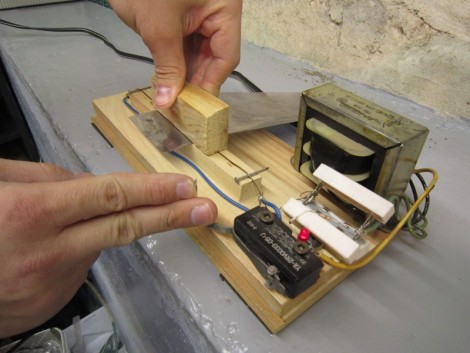
[Raphaël Assénat] needed anti-static bags for some boards he is selling. He had a lot of leftovers on hand (presumably from the components he ordered to assemble these boards) and wanted to reuse them. Instead of buying a heat sealer he built his own to cut them down to size.
His build starts with a transformer to drop mains voltage down to 9 Volts. From there, you can see the two power resistors used in series to limit the current. Without these, the wire would get way too hot. Just in front of those resistors is a momentary push switch which cuts the power by default. Here we can see that [Raphaël] is using a wood block to press the bag against the wire as it heats up.
The wire itself is a piece of straightened tension spring. Apparently this spring material is a poor conductor, which is why it gets hot enough to melt the plastic bag when you run current through it.















Also try guitar wire. And a thin strip of PTFE vs wood to avoid the element getting too hot and having the bag stick.
I think I saw 3 resistor there OP,very nice post.
Will most likely build one next week =P
Could you use a FoodSaver (or similar) to seal these kinds of bags? Can you use a FoodSaver to just seal and not vacuum?
Don’t own a FoodSaver, but have been thinking about getting one and getting into sous vide…if I could seal anti-static bags with it, that’d make for a neat multi-tasker…
What size are the resistors and power rating? Also is the Step down to AC so… 125vAC to 9vAC ? Or DC ?
Mine was around 19.5-+ v USA, unknown bag sealer
Using Ohm’s Law (R=V/I in this case), the resistance can be found by dividing the voltage by the current, so the combined value of the resistors AND the hot wire should about 1.8 ohms. I suspect that anyone who wants to make one of these should experiment with various resistor values until they find what works best for their particular setup.
This might just be worth a try…
@Dave,a food saver should work check this out:
http://hackaday.com/2011/11/09/hacking-a-vs200-food-sealer/
@atomsoft
from the picture it’s pretty certain it’s 9VAC but DC wouldn’t change the end result by much as if you have current flow,you have heat. The downside of DC I think would be heating of some parts of the circuit more likely.
Wow, very ghetto, but if its stupid and it works, its not stupid. :)
The wire itself is a piece of straightened tension spring. Apparently this spring material is a poor conductor, which is why it gets hot enough to melt the plastic bag when you run current through it.
¿poor conductor? Somebody inverted ohm's law and nobody tell to me!
yeah, I noticed that too. The important thing is that whatever you use doesn’t melt, and doesn’t oxidize excessively (which happens faster at high temperature). In any event, it’s the current that makes the heat. Nichrome wire would probably be ideal. Also, by using nichrome, which has higher resistance than other kinds of wire, you can dump less energy as waste heat in power resistors.
its not the current that makes the heat but the power (I*V) and ideally the resistance of the wire should equal the equivalent resistance of the transformer for most efficient energy transfer (slighly less than 50%)
Poor conductor as in good resistor.
Probably could have gone with some nichrome wire as the guy above said, but if this is cheap and works who cares.
If you used an ideal conductor then there would be no heat generated in the wire at all. all the heat would be generated in the internal resistance of the power supply components.
don’t worry, nobody change ohms law (probably explains why you didn’t get the memo…) just when you;re dealing with resistive heating you tend to need resitive materials!
I have a fondness for frankenstein projects that involve screwing unrelated components to a board. Old school!
When bread-boards live up to their name.
I vote change the words “resistors used in series” to “resistors used in parallel” or “parallel resistors used in series”
I love it, been thinking of doing this for some time only with copper desolder braid for more surface area but never got around to it
you of course can buy teflon tape for heat sealers online (no it’s not the same tape you use for water pipes..) – but a cheap source: check for non stick oven liners. it’s cookie baking season, and last year i got a few for $1 after rebate (just don’t get the silicone mats)
and an alternative wire source: the heating wire from an old toaster.
If you carefully “break” one of those resistors you’ll be able to recover the constantan wire, which you can use for sealing then.
Just the other day I was wondering about the possibility of heat sealing our ESD bags.
Timely!
“Apparently this spring material is a poor conductor, which is why it gets hot enough to melt the plastic bag when you run current through it.”
Mhmmm no, you want a good conductor to heat the wire, not sure what impedance you’d need cause the transformer complexes the matter
A good conductor will have a low resistance, as P=V^2/R, the larger your resitance in the wire, the more heat will be generated. If you use an ideal wire for example there would be no heat. E.g. Not a very good heat sealer.
So no, you don’t want a good conductor. Although I guess it depends on our definition of good
If P = V^2/R, then as R gets smaller, the power goes up.
What about using a piece of fuser sleeve film (from a old laser printer) over the wire?
(Sorry to resurrect such an old thread..)